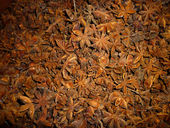
© Louisa Lim/NPRThe Chinese spice star anise contains shikimic acid, one of the active components in Tamiflu. Roughly 90 percent of the world's star anise is from China.
The star-shaped, licorice-smelling spice is normally used in stews and five-spice powder.
The swine flu outbreak has infected more than 8,000 people worldwide. In China, only three confirmed cases have been reported so far, but a surprising group of people is feeling the virus' economic impact.
Spice prices in a dusty covered market in Shanghai may seem an unlikely barometer of the level of public panic about new pandemic flus. But many people here believe that a star-shaped spice is a silver bullet against swine flu, and before that, bird flu. It's star anise, an orangey-red, licorice-smelling spice normally used in stews and five-spice powder.
The reason, as a spokesman for the drug-maker Roche explains, is that there are only two ways to produce the active ingredient for the flu-fighting drug Tamiflu - and one of them depends on star anise.
"One of the most important ingredients for Tamiflu is shikimic acid," says the spokesman, Cao Yong. "This stuff can be developed from star anise and the fermentation process in E. coli. That's the link."
Thirty pounds of star anise pods produce only one pound of shikimic acid. And 90 percent of the world's star anise is from China. Four years ago, when bird flu was the next big pandemic threat, a star anise shortage caused bottlenecks in Tamiflu production.
